

Ubuntu 12.04 LTS Precise Pangolin: Introducing MySQL Server. One of the fastest if not one of the best known database systems on today’s market is MySQL.
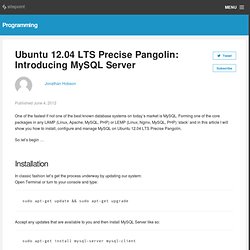
Forming one of the core packages in any LAMP (Linux, Apache, MySQL, PHP) or LEMP (Linux, Nginx, MySQL, PHP) ‘stack’ and in this article I will show you how to install, configure and manage MySQL on Ubuntu 12.04 LTS Precise Pangolin. So let’s begin … Installation. Linux Admin Steps Into Management. How to Display Network Open Ports in Linux with Netstat.
Ruby on Rails Guides. Ruby on Rails - Part 1: Hello World. Ruby on Rails - Part 3: Basic Rails. RoR ubuntu guide. Alternative to manual installation Some users may prefer to skip manual installation by using the unofficial pre-integrated TurnKey Ruby on Rails Appliance based on Ubuntu LTS.
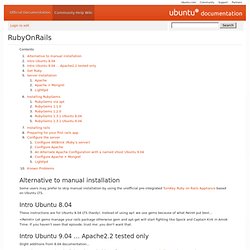
Intro Ubuntu 8.04 These instructions are for Ubuntu 8.04 LTS (hardy). Apache HTTP Server. The Apache HTTP Server, colloquially called Apache (/əˈpætʃiː/ ə-PA-chee), is the world's most used web server software.
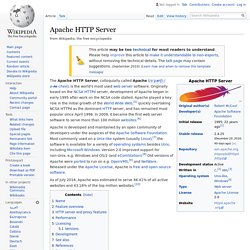
Originally based on the NCSA HTTPd server, development of Apache began in early 1995 after work on the NCSA code stalled. Apache played a key role in the initial growth of the World Wide Web,[5] quickly overtaking NCSA HTTPd as the dominant HTTP server, and has remained most popular since April 1996. In 2009, it became the first web server software to serve more than 100 million websites.[6] Apache is developed and maintained by an open community of developers under the auspices of the Apache Software Foundation. Most commonly used on a Unix-like system (usually Linux),[7] the software is available for a variety of operating systems besides Unix, including Microsoft Windows. How to Install And Configure Apache In Ubuntu.
FAQ. Frequently Asked Questions These are questions that have been asked over the years, on IRC, mailing lists, and various other less official channels.

Contents. Troubleshooting Common Apache Issues. This article provides troubleshooting guidelines for the Apache web server.
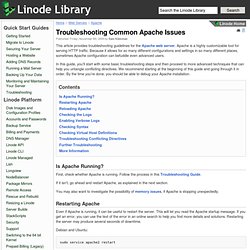
Apache is a highly customizable tool for serving HTTP traffic. Because it allows for so many different configurations and settings in so many different places, sometimes Apache configuration can befuddle even advanced users. In this guide, you'll start with some basic troubleshooting steps and then proceed to more advanced techniques that can help you untangle conflicting directives. We recommend starting at the beginning of this guide and going through it in order. By the time you're done, you should be able to debug your Apache installation. First, check whether Apache is running. Web container. A web container handles requests for servlets, JavaServer Pages (JSP) files, and other types of files that include server-side code.
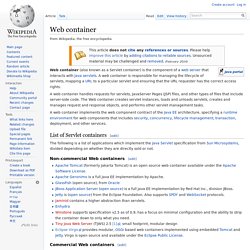
The Web container creates servlet instances, loads and unloads servlets, creates and manages request and response objects, and performs other servlet management tasks. The following is a list of applications which implement the Java Servlet specification from Sun Microsystems, divided depending on whether they are directly sold or not. Java Servlet. Life of a JSP file.

Introduction[edit] Servlets are most often used to:[citation needed] Process or store data that was submitted from an HTML formProvide dynamic content such as the results of a database queryManage state information that does not exist in the stateless HTTP protocol, such as filling the articles into the shopping cart of the appropriate customer To deploy and run a servlet, a web container must be used. Apache Tomcat. Apache Tomcat includes tools for configuration and management, but can also be configured by editing XML configuration files.

Components[edit] Tomcat 4.x was released with Catalina (servlet container), Coyote (a HTTP connector) and Jasper (a JSP engine). Catalina[edit] Catalina is Tomcat's servlet container. A beginner's guide to Tomcat 4/JSP. Version 4 brings Tomcat to the forefront as a JSP/servlet container.
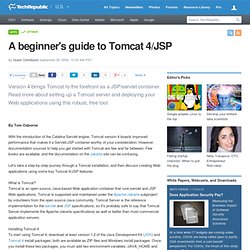
Read more about setting up a Tomcat server and deploying your Web applications using this robust, free tool. By Tom Osborne With the introduction of the Catalina Servlet engine, Tomcat version 4 boasts improved performance that makes it a Servlet/JSP container worthy of your consideration. However, documentation sources to help you get started with Tomcat are few and far between. Few books are available, and the documentation on the Jakarta site can be confusing. Resin Server. Resin Open Source is an open source version of the open core Resin Professional version that Caucho describes as "suitable for hobbyists, developers, and low traffic websites that do not need the performance and reliability enhancements of Resin Professional.
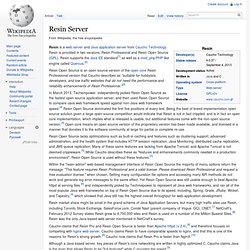
Resin. Resin 3.1 Documentation. JBoss Enterprise Application Platform. About the JBoss Way. The JBoss Way focuses on making sure developers are as productive as possible and enabling them to do great things. It's a development approach that provides developers a more productive and simple way to develop modern applications. The JBoss Way introduces a new set frameworks, tools and architectural designs. While JBoss is introducing new technologies, rest assured that you can reuse existing investments and integrate them while building modern applications that can leverage cloud and mobile capabilities. What differentiates The JBoss Way from other initiatives is its enablement aspect. Oracle WebLogic Server. Owned by Oracle Corporation, Oracle WebLogic consists of a Java EE platform product-family that includes: Application Server versions[edit] Capabilities[edit] Oracle WebLogic Server forms part of Oracle Fusion Middleware portfolio and supports Oracle, DB2, Microsoft SQL Server, MySQL Enterprise and other JDBC-compliant databases.
Oracle WebLogic Platform also includes: WebLogic Server Frequently Asked Questions. IBM WebSphere Application Server. Architecture[edit] WAS is built using Open standards such as Java EE, XML, and Web Services. It is supported on the following platforms: Windows, AIX, Linux, Solaris, i/OS and z/OS. Beginning with Version 6.1 and now into Version 8.5, the open standard specifications are aligned and common across all the platforms. Platform exploitation, to the extent it takes place, is done below the open standard specification line. DeveloperWorks : WebSphere. MySQL. MySQL (/maɪ ˌɛskjuːˈɛl/ "My S-Q-L",[6] officially, but also called /maɪ ˈsiːkwəl/ "My Sequel") is (as of March 2014[update]) the world's second most[nb 1] widely used[9][10] open-source relational database management system (RDBMS).[11] It is named after co-founder Michael Widenius's daughter, My.[12] The SQL phrase stands for Structured Query Language.[6] The MySQL development project has made its source code available under the terms of the GNU General Public License, as well as under a variety of proprietary agreements.
MySQL was owned and sponsored by a single for-profit firm, the Swedish company MySQL AB, now owned by Oracle Corporation.[13] LAMP (software bundle) The acronym LAMP refers to first letters of the four components of a solution stack, composed entirely of free and open-source software, suitable for building high-availability heavy-duty dynamic web sites, and capable of serving tens of thousands of requests simultaneously. The meaning of the LAMP acronym depends on which specific components are used as part of the actual bundle: